
We recommend you visit the interactive version. The text to the right is provided for printing purposes.
|


|
|
You open your eyes and find yourself sitting across from this man. He introduces himself: Mark Siddall of the American Museum of Natural History. Yes, those are leeches on his arm, 12 of them. But those "fingerlings" are like minnows to the sturgeon Mark will be seeking out momentarily, thigh-deep in a nearby swamp, with you at his side. As he smiles and guides you off the verandah, you consider what you'd urgently like to know about the giant Amazonian leech, the near-mythic creature he's seeking. How big? Well, it's the world's largest bloodsucking leech—by a good bit. Any other questions?—Peter Tyson
|


|
|
"Uh, just where am
I?"
You're in French Guyana, a steamy tropical country sandwiched between Surinam and Brazil. French Guyana is infamous for Devil's Island (seen in the distance here). Featured in the movie Papillon, it's a former penal colony, from which escape was reputedly impossible. French Guyana is also known for Haementeria ghilianii, the giant Amazonian leech, which occurs only here and in nearby parts of Brazil. An Italian naturalist named Vittore Ghiliani discovered the animal in 1849, hence its species name. Its generic name—from the Hellenic haema, meaning "blood"—is a nod to its exquisite blood-drinking ability.
|
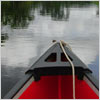

|
|
"Where are we
going?"
You're heading into unspoiled marshes near the country's tropical coast. If you're hot and sticky, don't worry. See those clouds ahead? It's December, the start of the rainy season, and each afternoon usually ends with a downpour. It's a great time of year to meet with the giant Amazonian leech. Its kind is just emerging from the bottom muck, where they dug themselves in to wait out the three-month dry season. They'll be vigorously searching for their favorite meal: fresh mammal blood. Grazing cattle usually provide the juice, but you'll do. The leeches aren't too discriminating, and they're hungry. Real hungry.
|
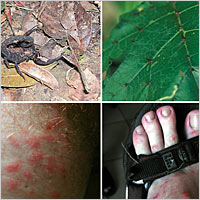

|
|
"What are we doing in the
forest?"
Oh, sorry. To get to the swamps, first you have to ditch the canoe and hike through tropical forest. Watch your step. See that scorpion? Mark says a sting from this species could be lethal. But don't stop, otherwise your foot may be swarmed by fire ants. Their bite, Mark says, feels like a hot needle driving into your flesh. (Those are bite marks on his foot.) Don't brush up against any shrubs either, like the spiky-leaved plant at right, or any trees for that matter. That rash on Mark's left arm? From a toxic tree resin. Oh, and keep an eye out for the fer-de-lance. It's a large, deadly, and highly aggressive pit viper.
|


|
|
"Glad to be out of the
woods. Are we there yet?"
Yup. This is classic habitat for the giant Amazonian leech. These savannah swamps fill with one to four feet of freshwater in the wet season. Mark's already up to his knees; soon he'll be up to his waist, and so will you. Look at the bright side—your lower extremities will be unavailable to the bugs. Leech expert Roy Sawyer, who grew up in the swamps of South Carolina, wrote after coming here in 1975, "I had never experienced such intense attacks from mosquitoes and biting flies." Mark already has three to four dozen chigger bites; he'd show you, but they're in, he whispers, "the nether regions." Perhaps that's why he looks a bit uncomfortable. Or maybe he's just thinking about all the creatures in this swamp that can injure or kill a person.
|
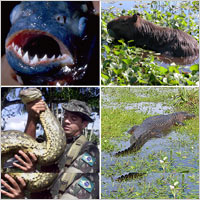

|
|
"What creatures?"
Well, you could step on an electric
fish and get a nasty shock, or step in a pool of piranha and get a nasty
de-fleshing. (Check out that piranha's dentition, will you?) "As
long as it's the rainy season and they have enough to eat, you're
okay," Mark yells over. You might surprise a capybara, the world's
largest rodent—this one probably weighs as much as a German shepherd. If
you come across a caiman, pray it's the spectacled (lower right in image) and not
the black, which can reach over 20 feet in length. So, for that matter, can the
anaconda, which loves to wrap its thigh-thick self around submerged plants in
this swamp. And then, of course, there's the giant Amazonian leech, of
which a French scientist wrote in 1899, "a few of these enormous leeches
are sufficient to kill a cow or a horse."
|
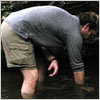

|
|
"How do we find these
leeches?"
No worries there—they find you. You're the bait. You can't set traps for leeches, so the standard method is to bare your legs and wade out into its domain, like Mark is doing here. He's bending over because it's hard to see approaching leeches. Their skin is a deep green-brown and the water is the color of dark tea and your feet stir up the mud. But don't worry, they can sense you from as far away as a ripple will travel, Mark says, and if they're near enough, they'll either undulate over like a living ribbon or they'll "inchworm" along surface plants or the bottom using their head as a second foot. They don't have eyes per se, but their eyespots are so sensitive that if you wave your hand across their field of vision, they'll track the movement. And they can sense your shadow. So there's little chance they won't find you.
|
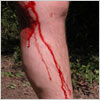

|
|
"Will I feel it if one
bites me?"
Probably not. But that's not
because it has an anesthetic in its saliva, for which Mark says there's
no scientific evidence. Rather, he says, it's because your waterlogged
legs are desensitized. There's another reason you won't feel the
bite—the giant Amazonian leech doesn't bite. It stabs. Unlike the
jawed leeches, including the famed medicinal leech (Hirudo medicinalis), whose three miniature jaws work in tandem to slice
your skin open, H. ghilianii is a so-called proboscis leech. It has a muscular tube up to six inches long—Mark dubs
it a "tongue straw"—that it jabs into your flesh
hypodermically. "It can go rather deep into tissue," he notes. And
its saliva releases an anticoagulant that keeps your blood flowing long after
you scrape the leech off, as you can see here.
|
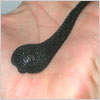

|
|
"What's this thing
look like, so I'll be ready?"
It looks like this. See the ridges? Like all bloodsucking leeches, it's got 34 segments, each of which has its own brain (or ganglia). Thirty-four brains—not bad for a slimy little worm, eh? In fact, leeches are related to earthworms, and they are slimy. When it's annoyed, Mark says, H. ghilianii, for instance, produces a gooey mucous in hopes of slipping away. See how it's fatter at one end than the other? That's the hind end, with its powerful sucker; the head is at the narrower tip. When the leech is in your hand, Mark says you can feel its muscles. Those muscles ripple with undulatory waves as it feeds, probably to help ferry ingested blood into its digestive tract. By the way, this is just a youngster. You'd hardly call this a giant leech, would you?
|
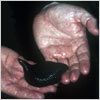

|
|
"Just how big do they get,
anyway?"
Well, here's the biggest one
Mark found on his expedition to French Guyana in 2002. It's kind of hard
to tell how long it is, because it's in the midst of something called
"shortening." Like all soft-bodied animals, leeches have two types
of muscles in their body walls—an outer circular layer and an inner
longitudinal layer. When it moves, the leech elongates its body by contracting
the circular muscles, then "shortens" it by contracting the
longitudinal muscles. Its muscles are also ideal for swimming. Anyway, to be up front with you, this isn't as large as they get, not by
a long shot.
|
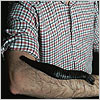

|
|
"Please tell me how big
they get."
Calm down. About the length of a man's forearm. (This is Roy Sawyer's forearm.) When fully stretched out, that translates, in the largest specimens, to 18 inches long. How would you like to have that squeezing between your bare toes? Squeezing through tight spaces is, in fact, a leech specialty. One expert describes how he closed his fist tightly on a leech, but it still managed to push its way out between his fingers. The giant Amazonian leech is no less hardy. Mark says you could probably step on one and not kill it. And leeches in its family can lose up to 80 percent of their body water and survive. Mark tells the story of some captive leeches that escaped and ended up in the back of a pickup truck in the hot sun for a day and a half before being found. The poor shriveled things were plopped in water and, within hours, they'd hydrated back to their old selves.
|
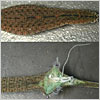

|
|
"Okay, I'm
thoroughly spooked. With everything that can get you out here, what's the
point?"
Mark is here to collect fresh specimens of H. ghilianii. Why? Well, even though these animals feed exclusively on it, blood alone is not able to sustain them; it lacks certain essential amino acids and vitamins. To make up for this deficit, bloodsucking leeches have evolved symbiotic relationships with special kinds of bacteria, which live in organs called mycetomes attached to the leech's esophagus. In exchange for a safe place to live, the microbes contribute the missing nutrients, Mark believes. He also suspects that H. ghilianii hosts a unique group of bacteria that provide this service, and he wants to find specimens (top) and look inside them (bottom). His work will help explain how such symbiosis evolved. By the way, check your legs—you might be fattening a giant Amazonian leech or two. Nothing like contributing to science, eh?

|
|
|




